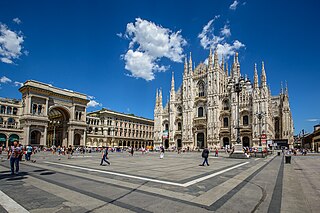
Lecce is a city in southern Italy and former capital of the province of Lecce, with the second-highest population in the Apulia region. It is on the Salentine Peninsula, at the heel of the Italian Peninsula, and is over two thousand years old.

Circumvesuviana is a railway network in the east of the Naples metropolitan area, previously run by a company of the same name, now operated by Ente Autonomo Volturno. Electrically powered throughout, the system uses the narrow gauge of 950 mm and operates 142 km (88 mi) of route on six lines. It is entirely separate from other national and regional railway lines. It has 96 stations with an average interstation distance of 1.5 km (0.9 mi).

Castello Sforzesco, known in English as Sforza Castle, is a medieval fortification located in Milan, Northern Italy. It was built in the 15th century by Francesco Sforza, Duke of Milan, on the remnants of a 14th-century fortification. Later renovated and enlarged, in the 16th and 17th centuries it was one of the largest citadels in Europe. Extensively rebuilt by Luca Beltrami in 1891–1905, it now houses several of the city's museums and art collections.

Giugliano in Campania, also known simply as Giugliano, is a city and comune (municipality) in the Metropolitan City of Naples, Campania, Italy. A suburb of Naples, as of 2017, it had some 124,000 inhabitants, making it the most populated Italian city that is not a provincial capital.

Castel Nuovo, often called Maschio Angioino, is a medieval castle located in front of Piazza Municipio and the city hall in central Naples, Campania, Italy. Its scenic location and imposing size makes the castle, first erected in 1279, one of the main architectural landmarks of the city. It was a royal seat for kings of Naples, Aragon and Spain until 1815.

During World War II the Italian city of Naples suffered approximately 200 air raids by the Allies from 1940 to 1944; Milan was the only Italian city attacked more frequently. Almost all of the attacks — a total of 181 — were launched in the first nine months of 1943 before the Four days of Naples and the Allied occupation of the city at the beginning of October. Estimates of civilian casualties vary between 20,000 and 25,000 killed.

Pendino is one of the 30 quartieri of Naples, southern Italy.

Arenella is a quarter of Naples, southern Italy. It is on the Vomero hill above the city and was, 300 meters in elevation. Many years ago was considered a place to go to "get away from it all". It is near to the main hospital section of the city, set somewhat higher, on the way up to the Hermitage of Camaldoli. It has some points of historic interest, such as the presence of the workshop of Giambattista della Porta.

Secondigliano is a modern suburb in the north of Naples, Campania, Italy. It is part of the 7th municipality of Naples, along with the suburbs of Miano and San Pietro a Patierno.

The Four Days of Naples was an uprising in Naples, Italy, against Nazi German occupation forces from September 27 to September 30, 1943, immediately prior to the arrival of Allied forces in Naples on October 1 during World War II.

Nola is a town and a municipality in the Metropolitan City of Naples, Campania, southern Italy. It lies on the plain between Mount Vesuvius and the Apennines. It is traditionally credited as the diocese that introduced bells to Christian worship.

The Zone 1 of Milan, since 2016 officially Municipality 1 of Milan, is one of the 9 administrative divisions of Milan, Italy.

Sant'Anna a Capuana is a church located on the piazza of the same name in Naples, Italy.

The church of Santi Cosma e Damiano a Porta Nolana is a Baroque-style church in central Naples.

The Mercato di Porta Nolana is a pedestrian market, mainly of seafood and produce on via Nolana in Naples, Italy. It is most crowded in the night before Christmas Eve when the locals buy the seafood for the traditional meals. It is located off Piazza Nolana, parallel to Corso Giuseppe Garibaldi, thru Porta Nolana, near a local train station, Porta Nolana with the Circumvesuviana lines.

The Port'Alba is the remnant of one of the city gates in Naples, Italy. It is located on the northwestern edge of Piazza Dante, just north of Vanvitelli's colonnade, which obscures the bastion into which the gate was carved. The gate leads from the piazza into a pedestrian alley, Via d'Alba with shops selling music instrument, books, and restaurants. The passage leads ultimately to Piazza Bellini.

The Caffè Gambrinus is a historic, private cafe or coffeehouse in Central Naples, Italy on via Chiaia. It is located in the rear of the Palazzo della Prefettura, which lies in front and to side of the Royal Palace of Naples, both of which face the Piazza del Plebiscito. The name Gambrinus is a legendary somewhat tipsy figure of joviality, and his name is used for various brands and many establishments.

Porta Torre is a main fortified tower located in the town of Como, in Lombardy. It is 40 meters high and it was built in 1192, to defend the main entrance of the city.

The Altamuran Revolution was a three-month period of self-government of Italian town Altamura, right after the birth of the Parthenopean Republic which ousted the Bourbons and the Kingdom of Naples. The city of the Kingdom of Naples was then defeated and taken by the so-called Sanfedisti, led by cardinal Fabrizio Ruffo, after a battle on the city walls. After being defeated, most Altamurans managed to flee through Porta Bari, one of Altamura's main gates.

Napoli Porta Nolana station is the main and terminal station of the Circumvesuviana railways, today managed by the Ente Autonomo Volturno (EAV).




















